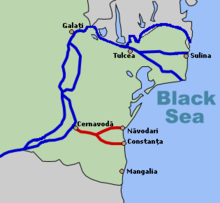Danube-Black Sea Canal
The Danube-Black Sea Canal ( Romanian Canalul Dunăre-Marea Neagră , also known as Cernavodă Canal or Cernavodă-Constanța Canal ) is an artificial waterway ( canal ) between the Danube and the Black Sea . It shortens the route from the Danube to the Black Sea by around 370 km (compared to the route that leads via Galați and Sulina ), while the Cernavodă-Constanța route is shortened by 450 km.
Course and technique
The canal begins at Cernavodă and flows into the Black Sea at Agigea , a suburb of Constanța . The north arm branches off at Poarta Albă , a canal connection to the Midia-Năvodari oil refinery . The Danube-Black Sea Canal has a length of 64.2 km, a width of 60 m and a depth of 7 m. The minimum curve radius is 3000 m. The north arm has a length of 26.6 km, a width of 50 m and a depth of 5.5 m. The minimum curve radius is 1000 m.
To equalize the water level between the Danube and the Black Sea, the canal has four lock systems : in the immediate vicinity of the Cernavodă nuclear power plant , to the Black Sea at the end at Agigea and at the end of the northern arm at the Midia-Năvodari refinery , as well in the course of the northern arm at Ovidiu .
In addition to the port facilities at the beginning and the ends of the canal arms, there are two more at Medgidia and Murfatlar .
The waterway is for individually sailing ships up to 5000 t with the dimensions 138.3 m length, 16.8 m width and 5.5 m draft and for push convoys with the dimensions 296 m length, 22.8 m width and 3.8 m Draft permitted for navigation. Ships and push convoys with maximum dimensions of 119.4 m in length, 11.4 m in width and 3.8 m in draft are allowed to enter the north arm.
history
The first projects to build a canal from Cernavodă to the Black Sea have been known since 1837. But when, from 1860, the newly built Cernavodă-Constanța railway made it possible to transport goods to the Black Sea, these plans were forgotten again. It was not until 1927 that the Romanian engineer Jean Stoenescu-Dunăre started a new project. The first construction work began in 1949, with tens of thousands of prisoners, including many of German descent and political prisoners, being used in forced labor camps . They received no wages and lived in the "Romanian Gulag Archipelago ". In 1953 work stalled for financial reasons. It was only from 1975 to 1984 the channel from was the Danube-Black Sea Baudepartement (CCDMN) completed the construction of the northern branch in the eastern section was carried out between 1984 and 1987. In this about moving 300 million cubic meters of earth, which is about twice the amount of the Panama Canal corresponded . The canal was also created for reasons of prestige and was entirely subject to Romania's sovereignty; in contrast to the Danube, which is subject to the joint control of the neighboring countries. Last but not least, he was also withdrawn from the influence of the Soviet Union .
After the canal was completed, deserving people received the specially donated “Danube-Black Sea Canal” medal .
Work-up
The Sighet Memorial , as a “Memorial to the Victims of Communism and Communist Resistance”, opened a memorial exhibition “The Danube-Black Sea Canal” in 2010 to commemorate the victims of the Danube-Black Sea Canal. A programmed cemetery ”. The exhibition was organized with the support of the Association of Former Political Prisoners in Romania (AFDPR), the Constanţa District Department of the State Archives and the Konrad Adenauer Foundation .
literature
- Wim van Meurs: The Danube-Black Sea Canal. A major construction site of communism , in: Yearbook for Historical Research into Communism (2012), pp. 113–128.
Web links
- Danube-Black Sea Canal , socialist advertising film
Individual evidence
- ↑ Der Brockhaus in one volume, 8th edition 1998, p. 204
- ↑ Memorial exhibition , The Danube-Black Sea Canal. A programmed cemetery.
Coordinates: 44 ° 20 ′ 48.7 ″ N , 28 ° 1 ′ 22 ″ E





